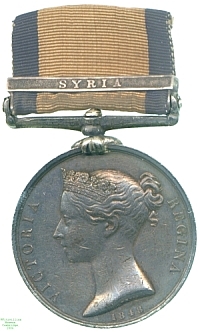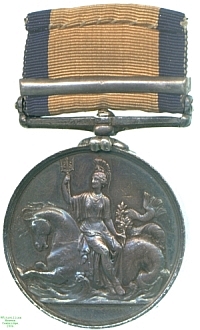
Obverse, a bust of Queen Victoria

Reverse, Britannia with a trident seated sideways on a seahorse

Obverse, a bust of Queen Victoria |

Reverse, Britannia with a trident seated sideways on a seahorse |
Just as in 1848 the extensive land campaigns of the Napoleonic Wars and the other conflicts of the pre-Victorian era were recognised by the issue of the Miltary General Service Medal, those serving in the Navy at the time were recognised with the Naval General Service Medal. As with the Army equivalent and the East India Company's related award, many of the battles for which the medal was awarded had been fought so long ago that few if any claimants survived.
In addition, bars were awarded for many actions whose significance and size were, despite the heroism displayed by those involved, relatively minor. The result was that many of the bars were issued in tiny numbers, with some combinations all but unique, and the medals command a very high price among collectors because of this rarity and individuality. This in turn, along with the manufacture in most cases of more bars than were eventually issued, has led to the `improvement' of many common awards where recipients' names are shared with those present at `rarer' battles. The medal also shares with the Military General Service and Army of India Medals the oddity that Queen Victoria, whose portrait they bear, was not the ruler under whom the battles for which it was awarded were fought.
The last two conflicts for which the NGSM was awarded share the oddity that both were fought alongside the French, unlike most of the rest of the bars to it, and both were fought against Ibrahim Pasha of Egypt, although his own allegiance had changed between the two. Whereas Ibrahim had been leader of the Ottoman forces fighting Greek rebels in the Greek War of Independence which resulted in the Battle of Navarino, by 1831 Ottoman distrust of his father, the Vizier Muhammad Ali, and his politics had led to Egypt being in open rebellion against the Turkish sultanate. As part of this Ibrahim was sent to invade Syria, and in 1832 he took the shore city of Acre by siege and defeated two Ottoman armies. He held Syria for six years before the Turkish Porte could face him again, and their immediate defeat led to intervention on the part of the Austrian Empire and Great Britain. On 4 November 1840 their combined Mediterranean squadrons, with assistance from the French, bombarded and retook Acre for the Ottoman Sultan Abdul Mejid I.
Since the NGSM was issued only 8 years later, unlike many of the bars awarded with it the bar for this campaign was issued in many thousands (7057 to be exact). This quantity has certainly led to a large number of Syria medals being retooled with surplus bars from rarer engagements which had featured men of the same names. Almost all of the recipients of the Syria bar (the exceptions being, in the words of Major Gordon, "those who served on board the Dido, Fury and Lady Franklin--a distinction for which I am unable to account" (British Battles and Medals (Aldershot 1947), pp. 88-89)) were also awarded, rather earlier, the Ottoman-issued St Jean d'Acre Medal.
34 British ships took part in the attack, among which was that aboard which there served one Francis Noake (his ship is not named on the medal). The presence of such a man in the force at this time has been verified, and the Medals Roll confirms the award of the piece to him, although it gives his name as `Noakes'. Lester Watson purchased the medal at some point before 1928.